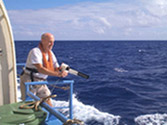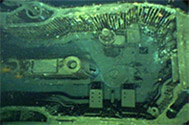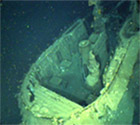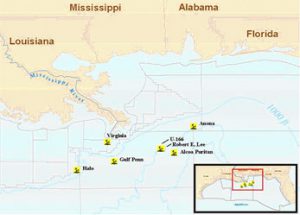
A team of scientists, including a University of Alabama marine biologist, will venture into the deep waters of the Gulf of Mexico on an 18-day research mission to investigate the long-term effect of manmade structures on the deep sea, and conversely, the effect of the environment on those structures.
The multidisciplinary group, overseen by the Interior Department’s Minerals Management Service, will depart Port Fourchon, La., July 29 aboard the NOAA contracted research and exploration vessel HOS Dominator. Dr. William Schroeder, professor of biological sciences in UA’s marine science program, who is stationed at the Dauphin Island Sea Lab, is involved in this investigation of World War II shipwrecks.
The MMS, in partnership with the National Oceanic and Atmospheric Administration’s Office of Ocean Exploration, under the auspices of the National Oceanographic Partnership Program, awarded a contract to C & C Technologies Inc. to conduct the research. MMS is providing $350,000 toward research costs and NOAA OE is funding the ship time, a deep submergence Remotely Operated Vehicle, and personnel for both, are provided by Sonsub Inc. of Houston.

The study has two separate but equally important objectives: an archaeological and historical objective and a biological objective. The archaeological objective is to document the wreck sites being investigated as historic properties significant to American history. The biological objective, Schroeder said, is learning whether the wrecks are serving as artificial reefs.
“We want to look at what’s growing on the wrecks, in regard to corals, and compare that with what’s growing on natural hard substrate at comparable depth ranges,” the UA professor said. “These wrecks could be serving as part of the functioning ecosystem in the deep Gulf of Mexico.”
 In the Gulf of Mexico, converting offshore oil and gas structures into artificial reefs on the continental shelf has been accepted as a benefit to fisheries. However, regarding the deeper waters beyond the shelf, additional information is needed about the significance of a deep-sea artificial reef effect.
In the Gulf of Mexico, converting offshore oil and gas structures into artificial reefs on the continental shelf has been accepted as a benefit to fisheries. However, regarding the deeper waters beyond the shelf, additional information is needed about the significance of a deep-sea artificial reef effect.
“The Gulf is the ideal laboratory for this study because of the number of steel-hulled ships that were casualties of World War II,” explained Rob Church, C & C Technologies’, project manager for the study. The Gulf represents one of the greatest concentrations of Allied vessels lost to German U-boats anywhere in the world, with 56 ships sunk in 1942 and early 1943.
According to MMS Marine Archaeologist Dr. Jack Irion, “Seven of these vessels, located during oil and gas surveys that are required by MMS, were selected for this study because they represent a range of depths (from 280 feet to 6,500 feet) and carried a variety of cargoes.

“Because the range of water depths represent different ecological niches and most of the vessels were sunk within a few months of one another, the wrecks offer a unique opportunity to study the artificial reef effect in differing depths after a period of 60 years.” In addition to the biological studies, the vessels will be documented and studied as historic sites for potential nomination to the National Register of Historic Places.
The UA scientist said there is much mystery surrounding the upcoming dive, in part because of the extreme depths the researchers will be exploring. “We don’t really know well what type of hard substrate habitats exist naturally in the deep Gulf of Mexico,” said Schroeder, a faculty member in UA’s College of Arts and Sciences. “We know that there are these oases — so to speak — such as the wrecks, scattered all over the world’s oceans. We are just beginning to document what’s there and what functional roles do they play in deep sea biology.
“We are going deeper than I have generally studied in the past. I don’t know what to expect. After 36 years of doing this, I’ve learned that whatever is there you accept it and then you begin asking, why is it there?”
Biologists will look at how the sediments have been modified by microbes in the immediate vicinity of the wreck sites, compared to sediments farther from the sites. The scientists hope to determine how tiny microbes cause the slow disintegration of steel structures at great depths, how the cargoes the ships carried might affect the rate of disintegration and how the biological communities might change as the ships deteriorate. In the end, the scientists hope to learn how manmade structures on the seafloor might act to enhance or detract from their environment.
The prime contractor, C & C Technologies Inc. of Lafayette, La., will be joined by a team of world-renowned scientists in the fields of microbiology and marine invertebrate and vertebrate zoologists. These scientists include Dr. Roy Cullimore of Droycon Bioconcepts Inc. of Regina, Saskatchewan, Canada, whose previous research includes microbial analyses of the RMS Titanic and, the DKM Bismarck, and the HMHS Britannic. Cullimore is joined by Schroeder; Dr. Thomas Shirley, professor of invertebrate biology at the University of Alaska-Fairbanks; and Dr. William Patterson, assistant professor of marine vertebrate zoology at the University of West Florida.
This study will have a significant outreach and education component, overseen by Dr. Annalies Corbin, executive director of the PAST Foundation and assistant professor of nautical archaeology at East Carolina University. A full curriculum based on each component of the mission will be available to all educational institutions in an easy to download format via the PAST Foundation website — www.pastfoundation.org. Included in the educational outreach will be an interactive project Web site, spearheaded by Andrew Hall, and a documentary film to be produced by award-winning filmmaker Dr. Dennis Aig, professor of media and theatre arts at Montana State University-Bozeman. Daily text and ROV still photos will be provided and there will be 2-3 minute streaming video pieces every other day.
“This field study is an exciting opportunity for all participants,” concluded John McDonough, project coordinator at NOAA OE. “We believe this joint effort will expand our knowledge in areas such as the management and preservation of historic shipwrecks and other submerged cultural resources. At the same time, this expedition uses ocean exploration and interdisciplinary oceanographic research to capture the public’s imagination with the message that we have a great deal to learn about Earth’s oceans and their effect on our lives.”
Further Reading